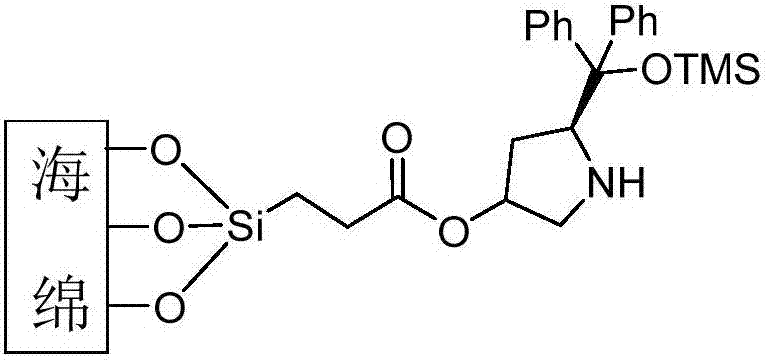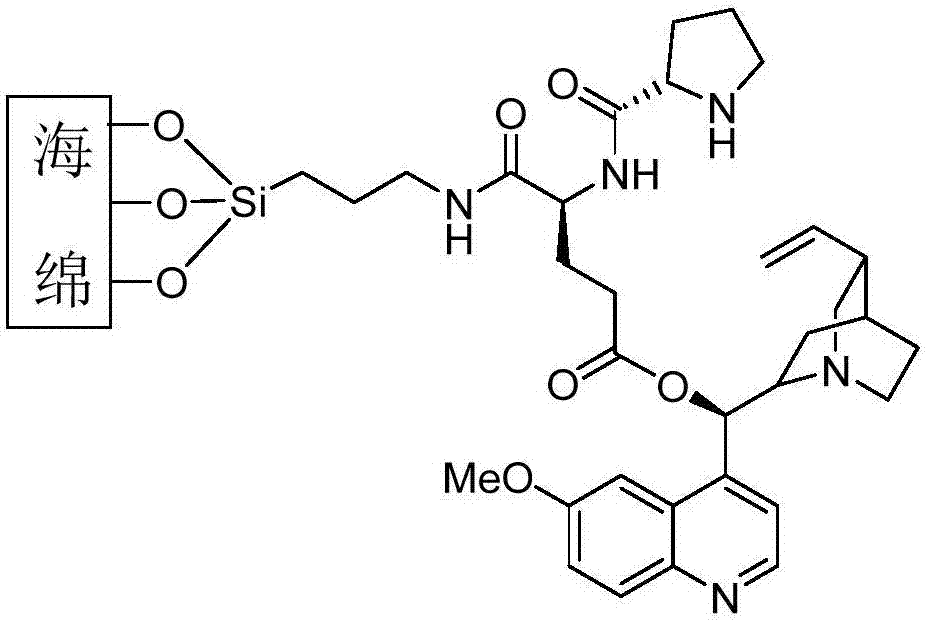Sponge loaded chiral organic catalyst
An organic catalyst, catalyst technology, applied in the direction of organic compound/hydride/coordination complex catalyst, catalyst activation/preparation, physical/chemical process catalyst, etc., to achieve controllable loading, high recycling rate, stable properties Effect
- Summary
- Abstract
- Description
- Claims
- Application Information
AI Technical Summary
Problems solved by technology
Method used
Image
Examples
Embodiment 1
[0076] A kind of chiral organocatalyst supported by sponge, said chiral organocatalyst supported by sponge is made of sponge, silylating agent and organic catalyst, wherein, said sponge is polydimethylsiloxane sponge containing surface hydroxyl ( PDMS), the silylating agent is 3-aminopropyltriethoxysilane modified with chloroacetic acid at the end group, and the chiral organic catalyst is trans-4-hydroxyl-L-proline shown in the following formula amino acid, and the silylating agent is supported on the surface of the sponge by reacting with the surface hydroxyl group of the sponge, and the chiral organic catalyst is bonded to the carboxyl group of the silylating agent through a covalent bond, and is connected to the Sponge surface. Wherein, the structure of the chiral organic catalyst is as follows, and the effect diagram of the chiral organic catalyst supported by the sponge is as follows figure 1 shown.
[0077]
Embodiment 2
[0079] A kind of chiral organocatalyst supported by sponge, said chiral organocatalyst supported by sponge is made of sponge, silylating agent and organic catalyst, wherein, said sponge is polydimethylsiloxane sponge containing surface hydroxyl ( PDMS), the Linker reagent is a 3-carboxypropyltriethoxysilane whose terminal group is a carboxylic acid, and the chiral organic catalyst is 4-hydroxyl-2-diaryl-2- Trimethylsilyl ether-L-proline, and the silylating agent is supported on the surface of the sponge by reacting with the surface hydroxyl of the sponge, and the chiral organic catalyst is covalently bonded to the modified The silylating agent is bonded, attached to the surface of the sponge. Wherein, the structure of the chiral organic catalyst is as follows, and the effect diagram of the chiral organic catalyst supported by the sponge is as follows figure 2 shown.
[0080]
Embodiment 3
[0082] A sponge-supported chiral organic catalyst, the sponge-supported chiral organic catalyst is made of sponge, silylating agent and organic catalyst, wherein the sponge is a polydimethylsiloxane sponge containing surface hydroxyl groups ( PDMS), the silylating agent is 3-aminopropyltriethoxysilane modified with glutamic acid at the end group, wherein the side chain of glutamic acid is selectively protected or removed, the chiral The organic catalyst is proline and quinine shown in the following formula, and the silylating agent is supported on the surface of the sponge by reacting with the modified surface hydroxyl of the sponge, and the chiral organic catalyst is covalently bonded The amino group and carboxyl group of the modified silylating agent are sequentially bonded and connected to the surface of the sponge. Wherein, the structure of the chiral organic catalyst is as follows, and the effect diagram of the chiral organic catalyst supported by the sponge is as follows...
PUM
 Login to View More
Login to View More Abstract
Description
Claims
Application Information
 Login to View More
Login to View More - R&D
- Intellectual Property
- Life Sciences
- Materials
- Tech Scout
- Unparalleled Data Quality
- Higher Quality Content
- 60% Fewer Hallucinations
Browse by: Latest US Patents, China's latest patents, Technical Efficacy Thesaurus, Application Domain, Technology Topic, Popular Technical Reports.
© 2025 PatSnap. All rights reserved.Legal|Privacy policy|Modern Slavery Act Transparency Statement|Sitemap|About US| Contact US: help@patsnap.com



